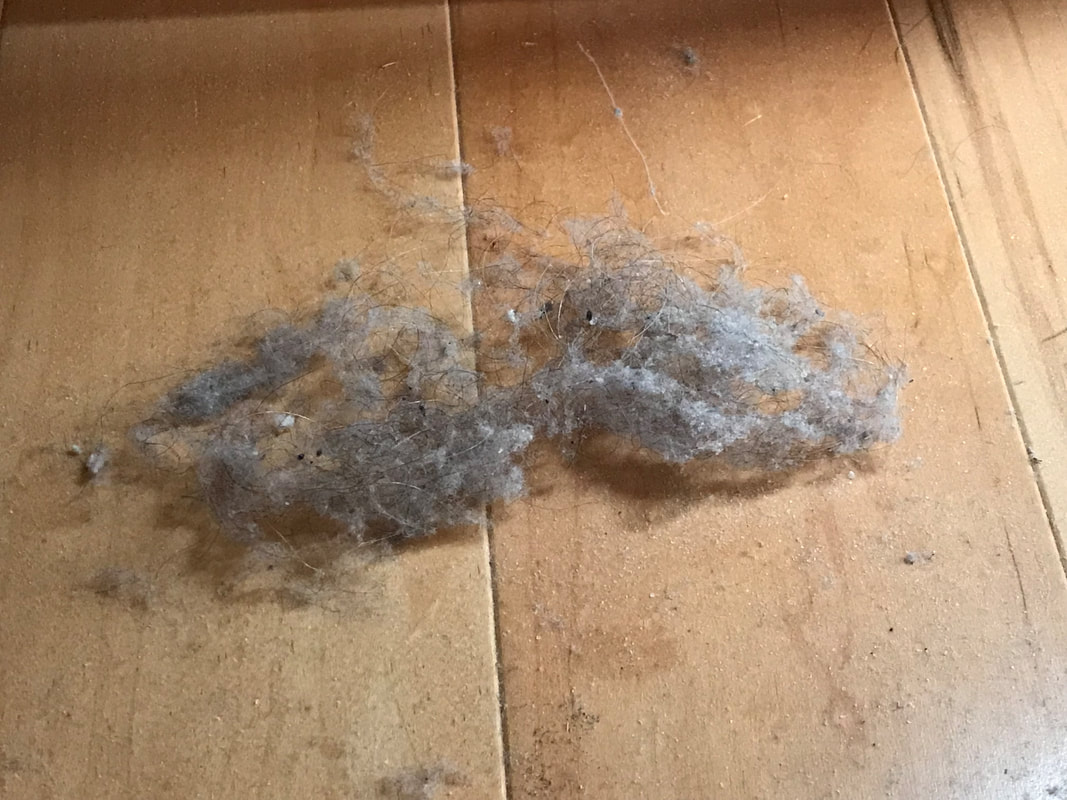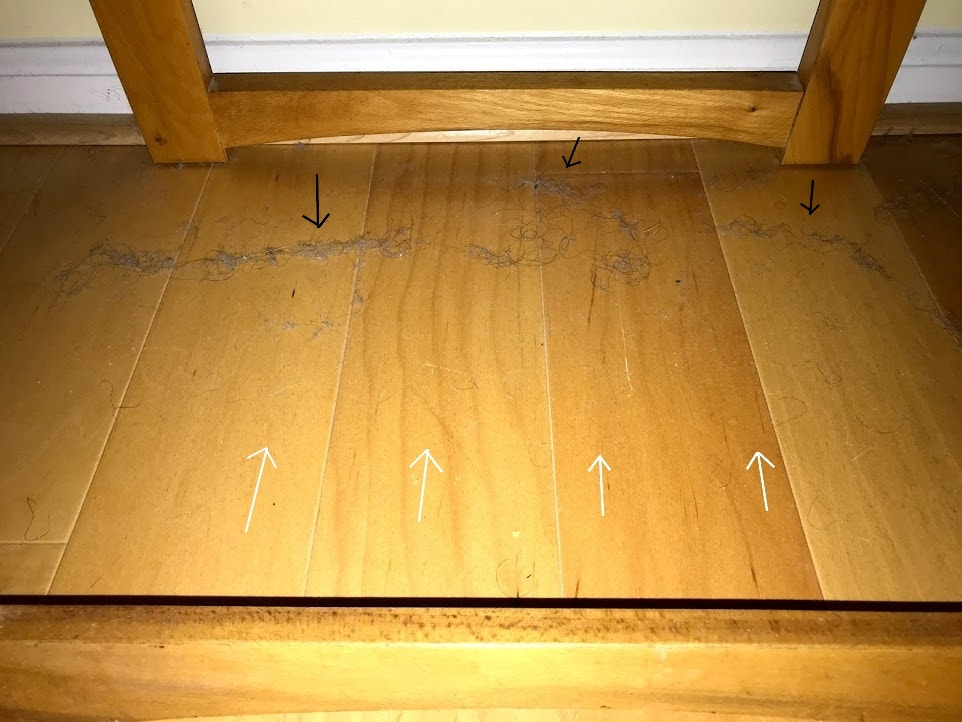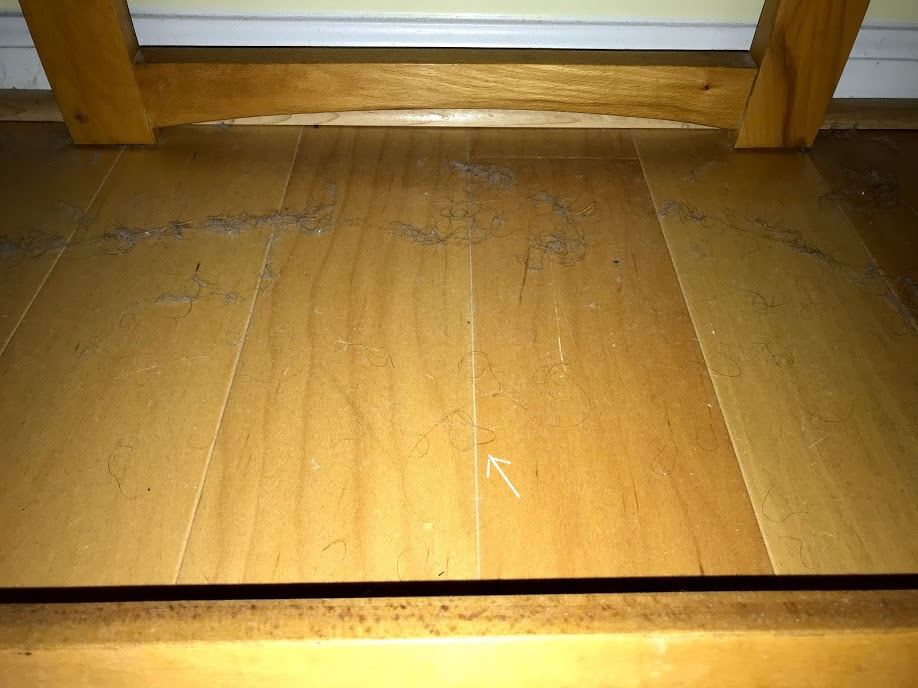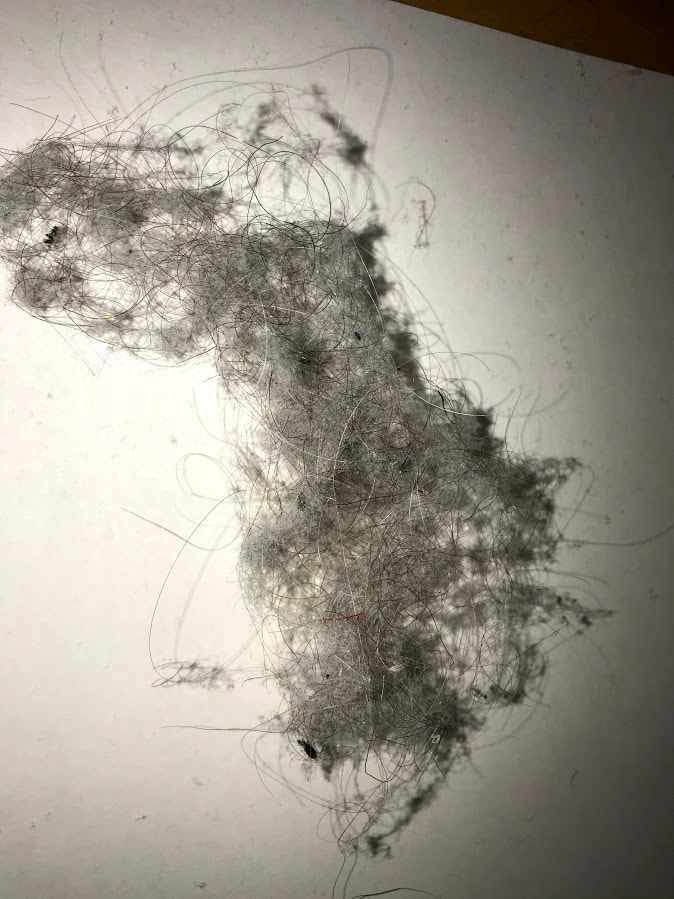|
There is a scientific question that has piqued my curiosity, but it’s not anything that if solved would be worthy of a Nobel Prize. I want to know how dust bunnies are formed. In case you don’t know, dust bunnies are the term assigned in the United States to those loose agglomerations of fibers and dust that you find in spaces that are not cleaned regularly. In the picture below you can see a dust bunny that formed under a chair in a room in my house. The color of this dust bunny is grey and it has the classical dust bunny cumulus cloud-like shape. To find out how dust bunnies like these are formed, I cleaned the space under this chair thoroughly and took a picture (see below). The picture above represents what we will call day-zero (day-0). To gain insight into the mechanism by which dust bunnies are formed, I decided to take sequential pictures in time hoping to capture different stages of dust bunny formation. I chose this particular space under the chair because I reasoned that if dust bunnies formed here once they would form again. The observation period was from August 18 to October 21 of 2019. The next picture I took was on day-16 and can be seen below. I could see that some fibers had appeared in the space under the chair (white arrows), but to my surprise a small dust bunny had also appeared in the upper left hand corner (red arrow)! However, I reasoned that this had occurred too soon, so I hypothesized that this particular dust bunny had come from somewhere else. To the left hand side of the chair there is a closet that receives a substantial amount of traffic throughout the day. When I checked it, sure enough, I found several dust bunnies among the stuff on the floor of the closet. I figured that people going in and out of the closet moving stuff could have created an air current that dislodged this small dust bunny and blew it towards the space I was surveying. Although I found this explanation plausible, it pointed to a weakness in my observational method. If dust bunnies could be blown in from elsewhere, how would I know if a particular stage of dust bunny formation was indeed a stage in the process or something that had been blown from somewhere else? Bearing this in mind, I removed the small dust bunny and decided to continue my observations. The next picture from day-32 can be seen below. You see the appearance of numerous lose tangles of fibers (black arrows) and what appears to be a small elongated tangle of fibers (white arrow). Now compare the location of the fibers in this picture to what you see in the picture below taken at day-45. Something interesting happened between day-32 and day-45. All the area occupied by the white arrows is mostly devoid of fibers, and what appears to be several elongated small dust bunnies have made their appearance towards the back of the space (black arrows). What I think happened is that an air current following the direction of the white arrows blew the tangles of fibers towards the back and made them assume their elongated appearance. I reasoned that if now an air current blew from the left to right, or vice versa, it could push all the fibers in the back into each other forming a regular dust bunny. The next picture below is from day-56. Not a lot seems to have changed between day-45 and day-56, but notice that the area previously devoid of fibers in day-45 now has a few small fibers that have appeared (for example white arrow). However, there was a big change between day-56 and day-64 (see below). On day-64 the classical cumulus cloud-shaped dust bunny appeared on the upper left hand corner (red arrow)! Could an air current blowing from right to left have formed this dust bunny? The size of the dust bunny seems a bit large to be accounted for by all the tangles of fibers present in the back of the space on day-56. Moreover, there is a much smaller dust bunny present on the upper right hand corner that is not seen very well in the picture (white arrow). The area to which the white arrow points, can be seen better in the picture below. Could the large dust bunny have come from elsewhere propelled by an air current blowing from left to right, while all the fibers seen on day-56 where blown to the right forming the smaller dust bunny shown above? This is where the weakness of my observational method that I alluded to while discussing the observations made on day-16 has come into play. My inability to trace the movements of the tangles of fibers has made it impossible to interpret the observations regarding this final stage of dust bunny formation. I collected the large dust bunny (see below). I took three pictures with a 10X magnification of different areas of the large dust bunny (see below). You can see the tangles of large fibers intermeshed with tangles of smaller fibers and dust particles that are known to make up dust bunnies. The fibers can range from hairs to those derived from clothes, plants, and other sources. Despite the shortcoming of my observational method, I want to propose a mechanism of dust bunny formation, or at least of those forming in open spaces like the one I surveyed. Before I do so, I want to recognize that others have proposed mechanisms similar to the one I propose below. I hypothesize that the fibers of different sizes are blown into each other and become intertwined forming lattices that more fibers can latch onto, and as this process continues the tangles of fibers increase in size. Small tangles get blown into each other and form large tangles that get blown into each other forming larger tangles and so on. As they are blown around, depending on the direction and duration of the air currents, the tangles may first develop elongated shapes and finally the roundish shapes typical of the classical cumulus cloud-like dust bunny morphology. The air currents are probably generated by people walking or moving items or when windows are opened or fans or other forms of ventilation are turned on. Once they are large enough, dust bunnies display a degree of cohesion, probably due to the meshing of their fibers and even electrostatic attraction, which allows them to be blown about by air current as tumbleweeds would. While dust bunnies can form by the slow accumulation of fibers and dust in an enclosed space protected from air currents, my hypothesis posits that air currents play an important role in the development of dust bunnies in open spaces, and suggests that a method to trace the movement of the tangles of fibers is necessary to study the formation of these dust bunnies. One way to do this is to have a camera in operation (dust bunny cam!), but the long time frames (64 days) and the dark to light changes in illumination may not make this a practical method. Another way is to use a certain amount of very fine particles of a light material such as Styrofoam or glitter that will not interfere with fiber tangle formation but that will blow with the fibers. This way the movement of the fibers could be traced in order to identify which dust bunny came from where. Finally, it should be possible to produce artificial dust bunnies in the laboratory if researchers supply the fibers, dust, and air currents. By varying the composition and size of the fibers and intensity and orientation of the currents, it should be possible to come up with a model of dust bunny formation that can be compared to the real process taking place in houses and other settings. Some possible questions to answer in future research through observation and experiment in the field of dust bunny formation are: 1) Despite the seemingly random appearance of the tangles of fibers in a dust bunny, do dust bunnies have some identifiable structure? For example, are the fibers that come together early to form the core of the dust bunny located in the center or bottom, while the fibers that are incorporated last are found in the periphery or on top? If a dust bunny forms in an enclosed space through the slow deposition of fibers, would the dust bunny have a layered structure? 2) Can a model of dust bunny formation be formulated? For example, as fibers are blown around by air currents, do dust bunnies form through a mechanism similar to that of a snowball rolling downhill and increasing in size, or are dust bunnies formed by the random attachment of tangles of fibers to each other like the individual components of a conglomerate rock? 3) Is there some particular characteristic of the fibers in a dust bunny (makeup, length, tensile strength, rigidness, etc.) that may favor its formation and cohesion? 4) What is the size limit of a dust bunny? Do dust bunnies reach a certain size where they lose their cohesion and are more easily broken up by air currents? 5) Is there a seasonal variation in the formation of dust bunnies? Is the cohesion of dust bunnies greater during the winter months when there is more static electricity? Does a particular type of climate (for example dry or humid) favor dust bunny formation? Do you have any ideas regarding the formation of dust bunnies and the mechanism(s) involved? Please leave a comment and let me know! The pictures belong to the author and can be used only with permission.
2 Comments
|
Details
Categories
All
Archives
June 2024
|










 RSS Feed
RSS Feed